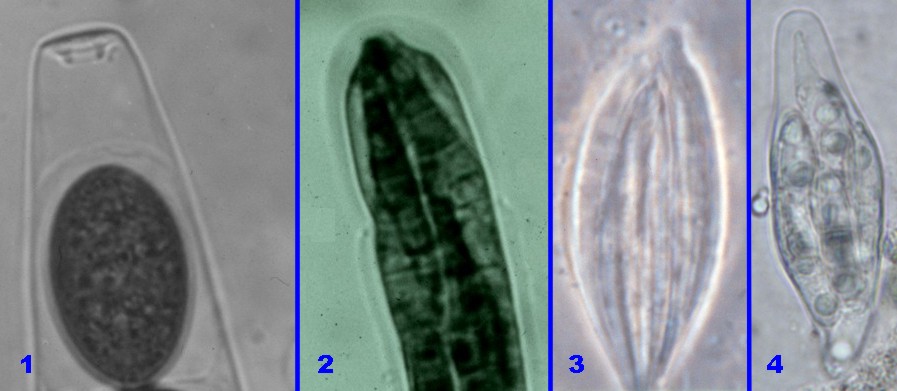DISCUSSION OF THE PYRENOMYCETES
Pyrenomycetes produce their asci in perithecia, flask- or vase-shaped structures, and in most cases are easily recognized in the field, providing you have a hand lens. Although they are similar to one another in appearance they are represented in four classes of fungi. These are: the Sordariomycetes or unitunicate pyrenomycetes, the Dothideomycetes or bitunicate pyrenomycetes, the Laboulbeniomycetes (there is no common name for these), and the Eurotiomycetes or lichen-forming pyrenomycetes.

The Sordariomycetes are all characterized by unitunicate asci having an apical pore or ring. In the illustration the ascus of Sordaria fimicola clearly shows the collar-like ring. The walls of the perithecium begin to be formed around a fertilized ascogonium (the cell in which the dikaryon is established). Usually the easiest way to recognize the group is by the thin-walled asci.
The Dothideomycetes have a bitunicate ascus. This ascus type, sometimes aply called the "jack-in-the-box" type, has a rigid outer wall and an extensible inner wall. When the spores are mature the outer wall, usually near the apex, breaks and the inner wall extends out to more than double its original length. The ascus of Acanthostigma sp. in Figure 2 illustrates the thickened apex of the ascus and the nipple-shaped protrusion of the ascus contents up into it. The walls of the perithecium are not formed from a basal proliferation of the ascogonium but are instead made up of tissues created by aggregations of hyphae or by the repeated divisions of a vegetative cell.
- The Laboulbeniomycetes are all parasites of insects and mites during all or part of their life cycles. Their asci are very simple, inconspicuous and thin-walled, with no apical pores or thickenings. The spindle shape in figure 3 is a common feature in this group. The ascospores are elongated, two-celled, and at maturity possess a dark apical spot that serves to anchor it to the cuticle of its host animal.
The Eurotiomycetes have asci that may appear similar to the bitunicate type. They are often thick-walled at the apex and do not open by a pore. Mycophysias ascophylli, the species illustrated in Figure 4, has narrowly pear-shaped asci with an elongated apical region typical of many Eurotiomycetes. Many members of the subclass Chaetothyriomycetidae form lichens and are thus not easily confused with members of the other classes of pyrenomycetes while none of the Eurotiomycetidae form lichens.